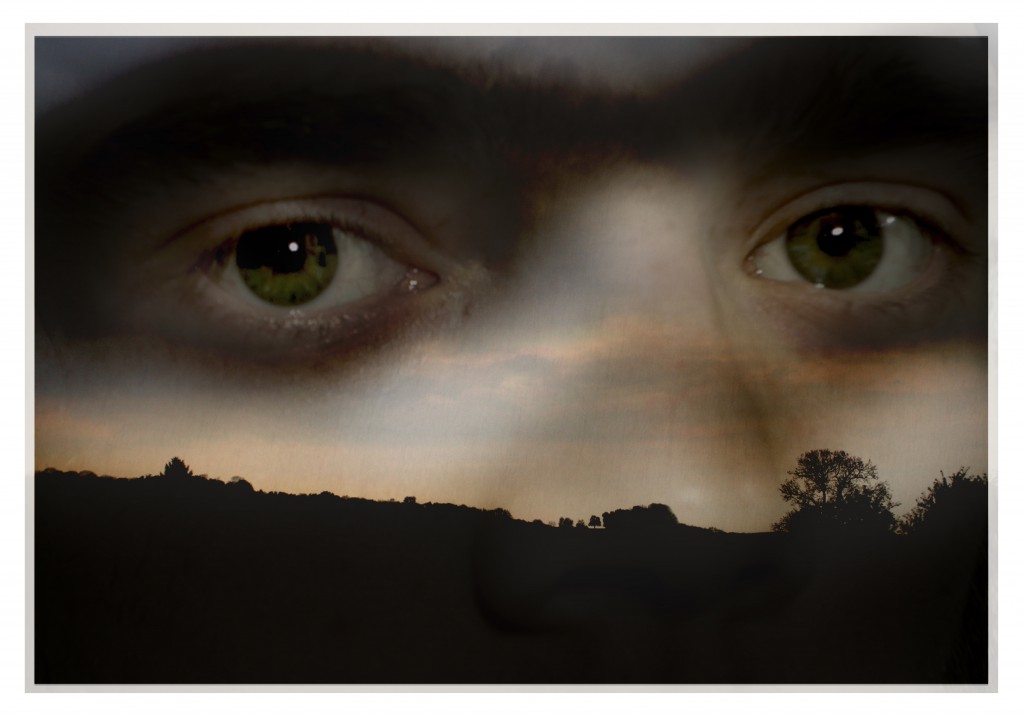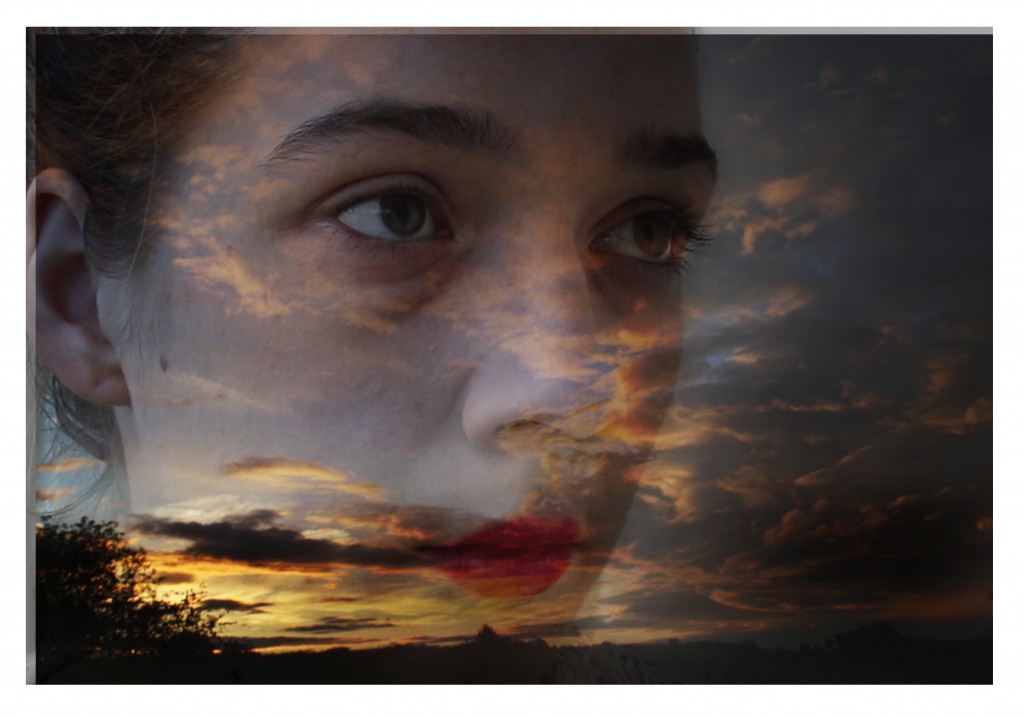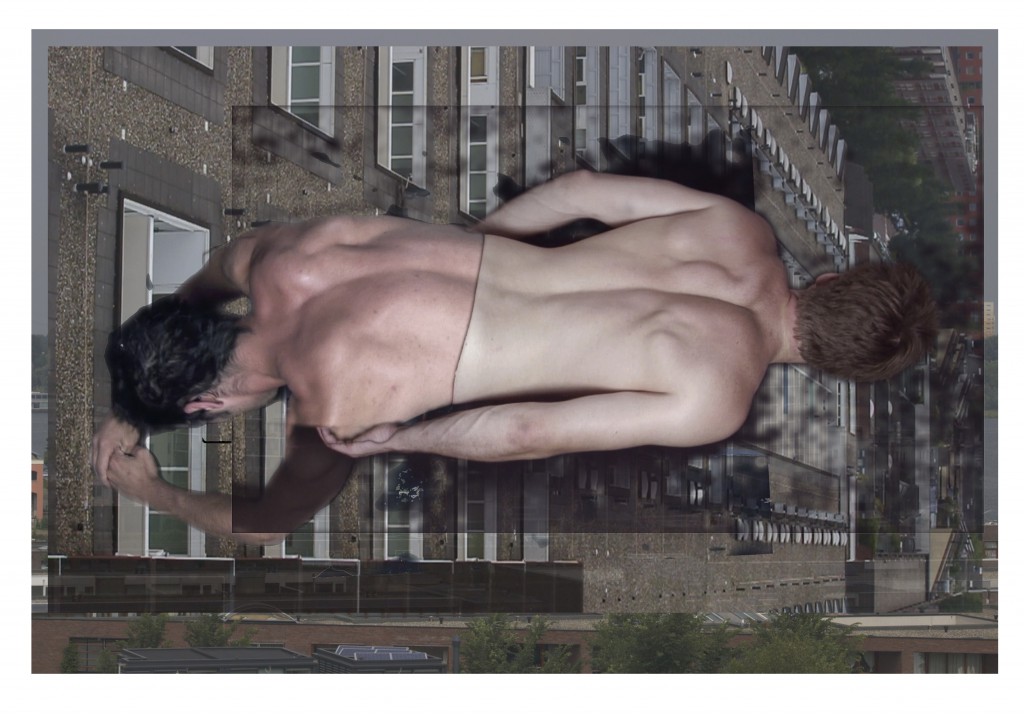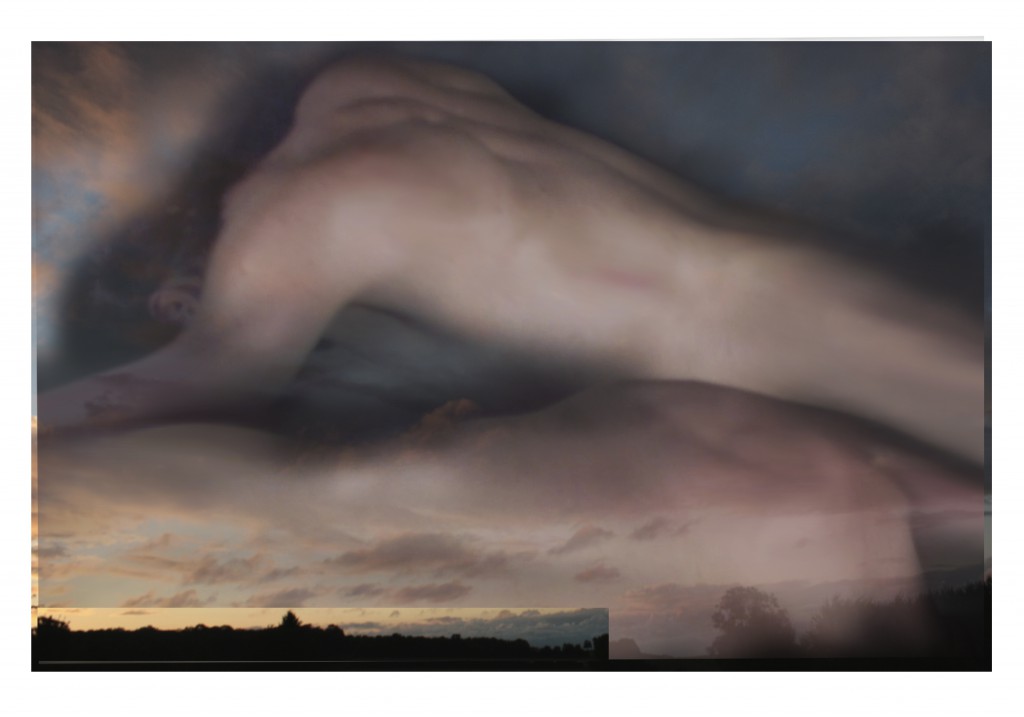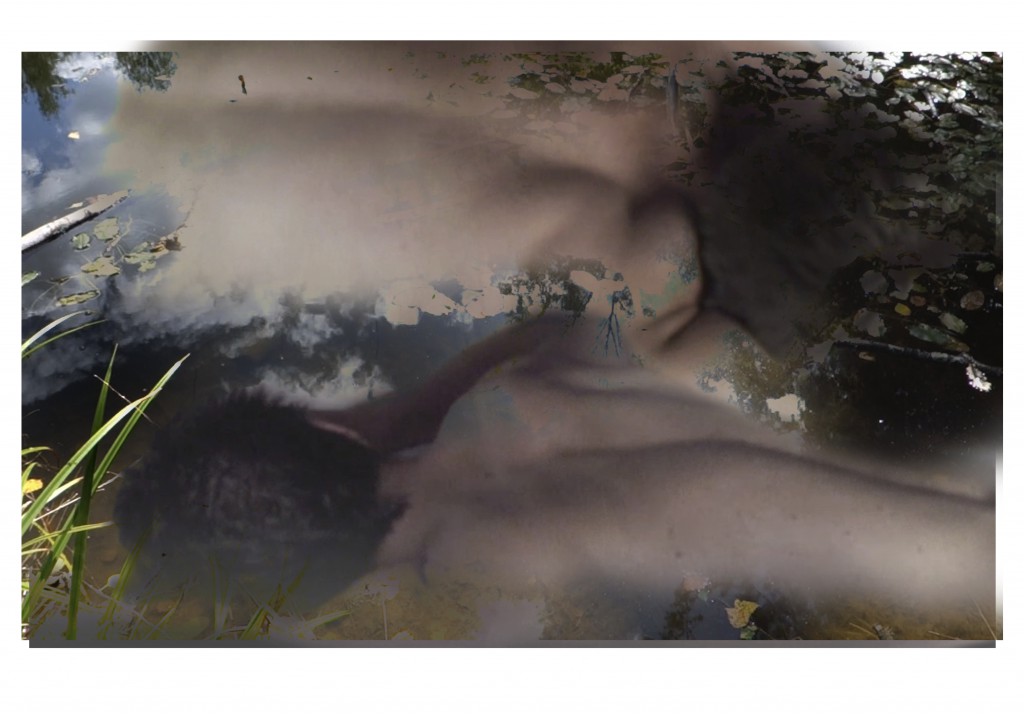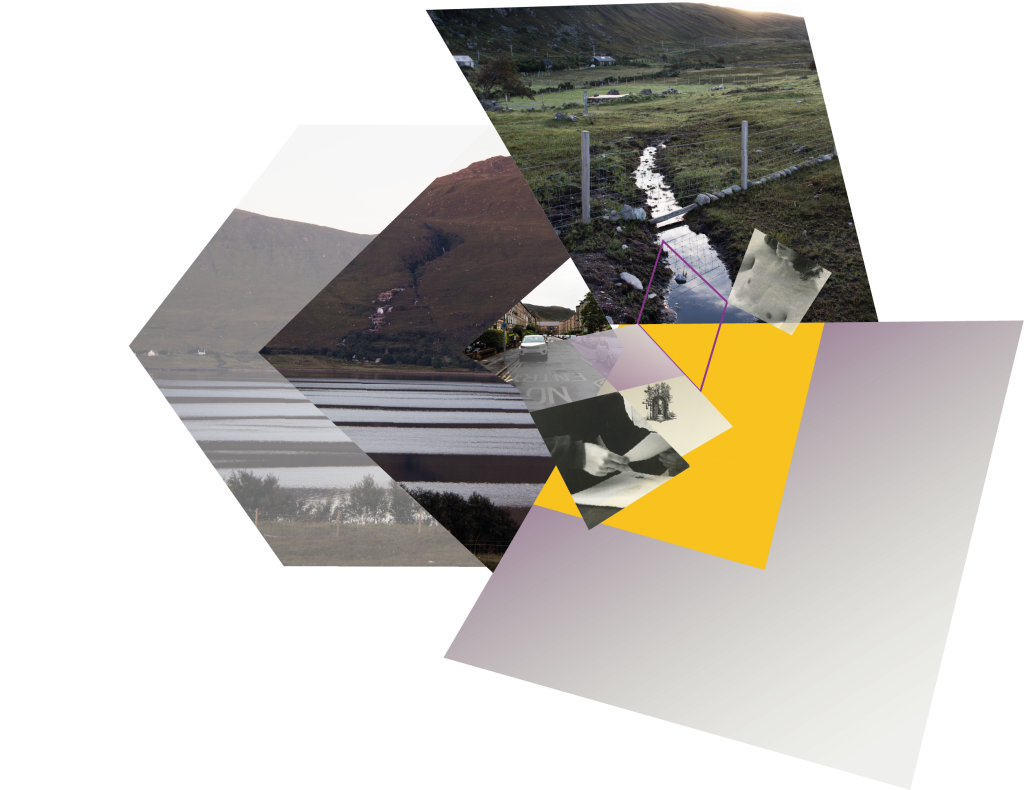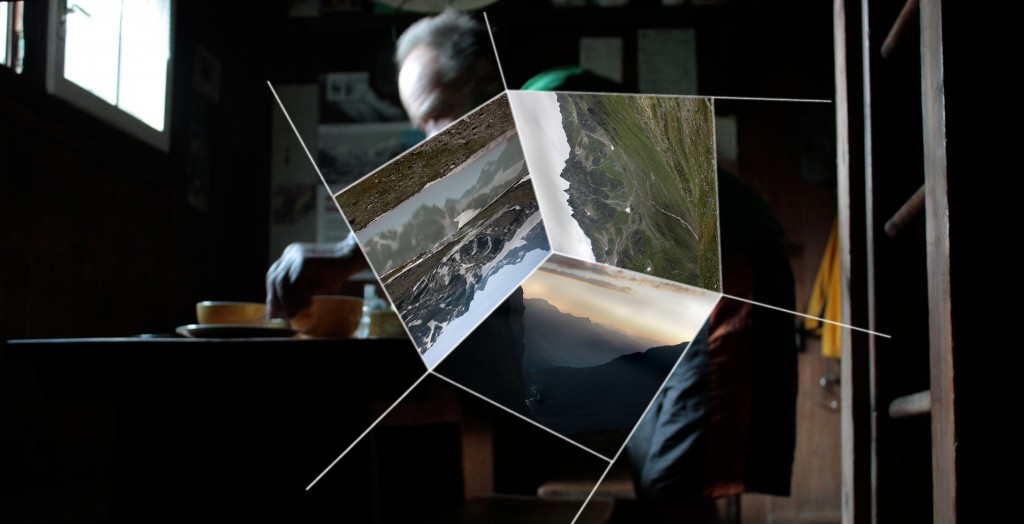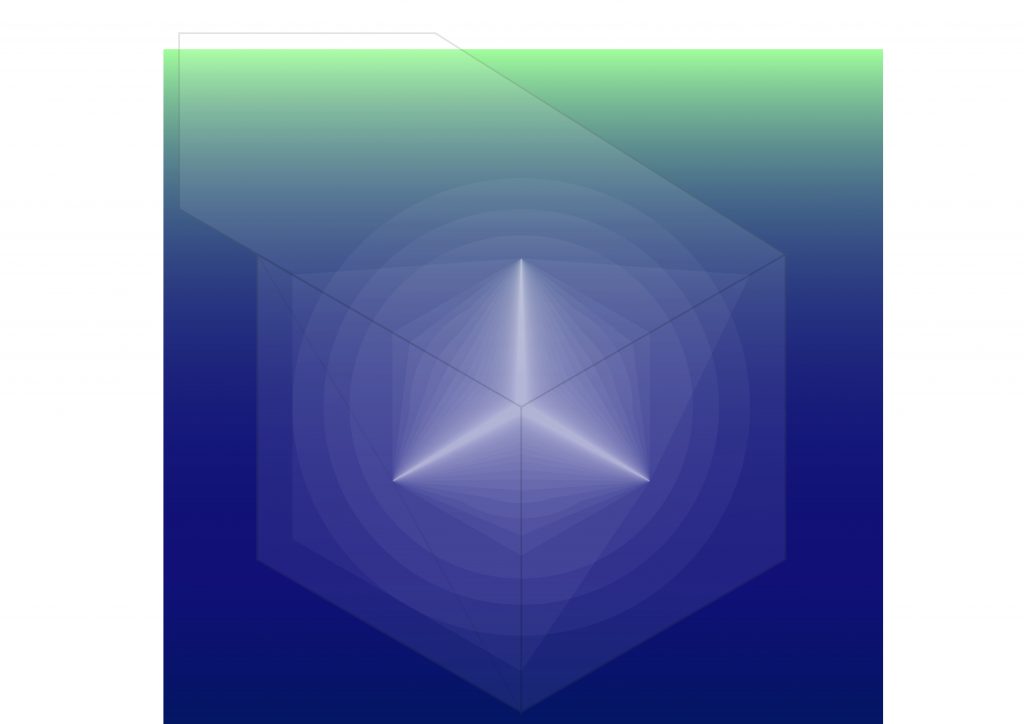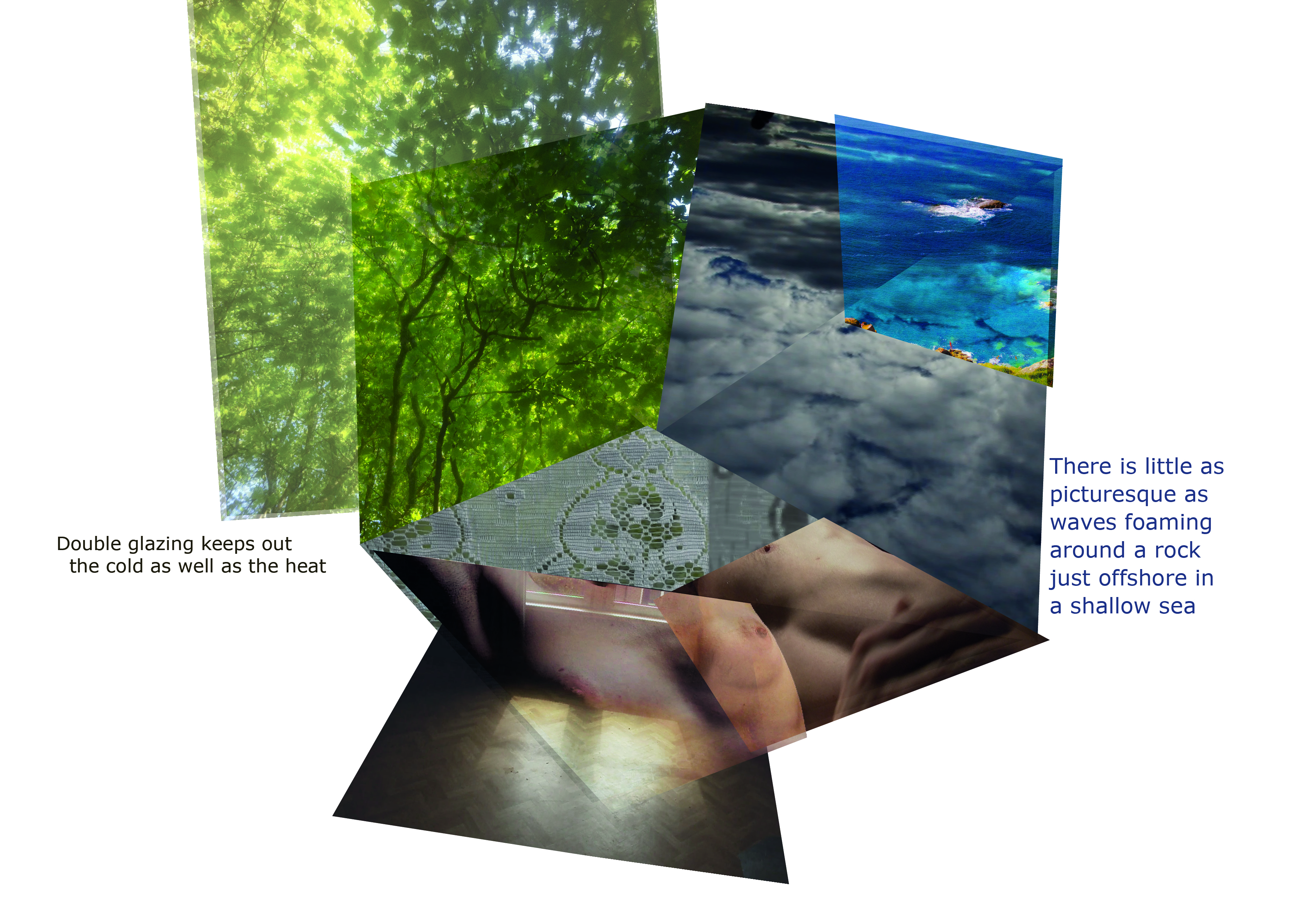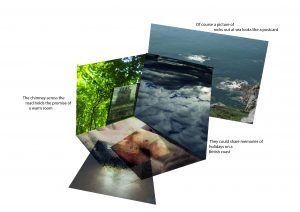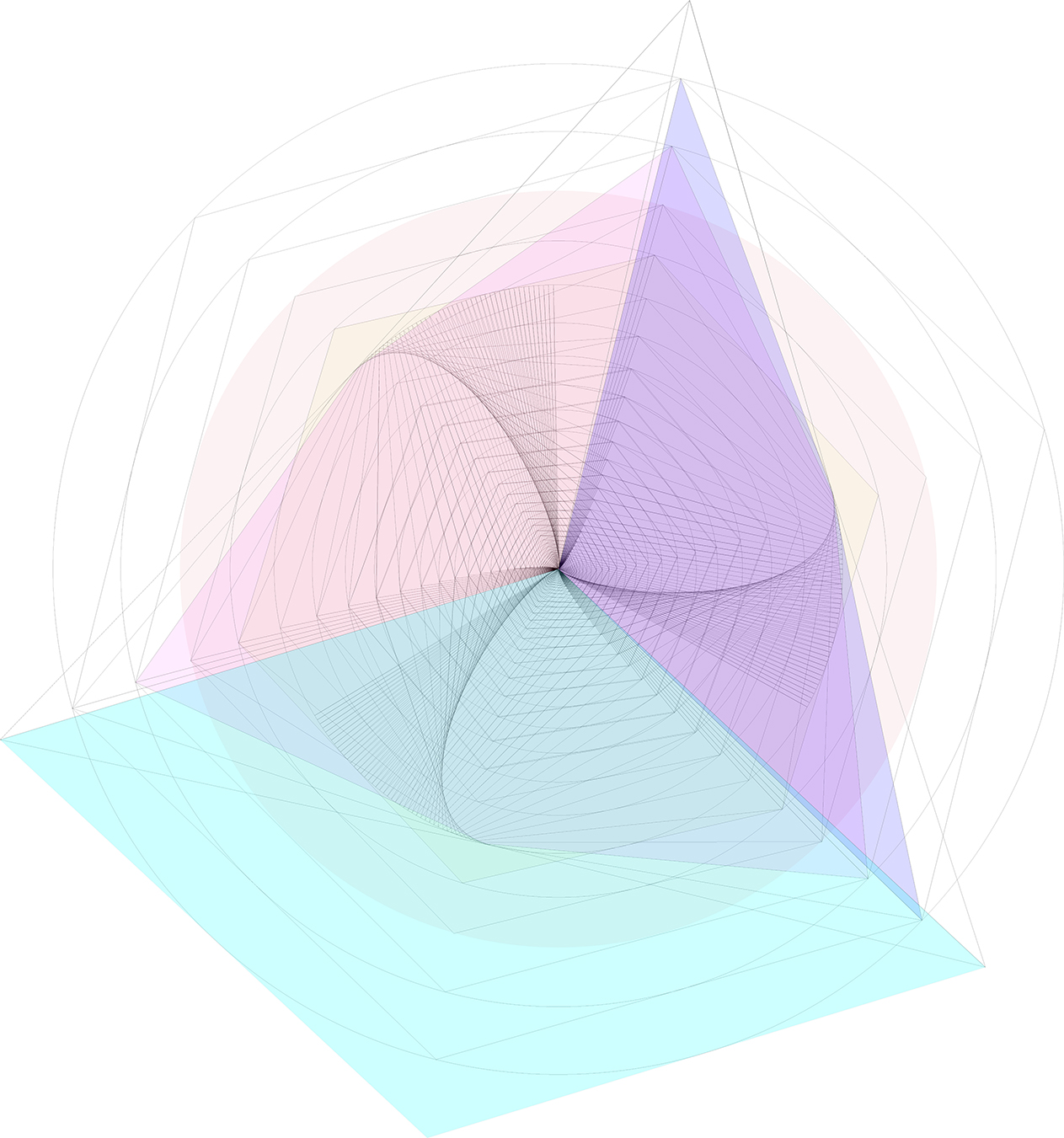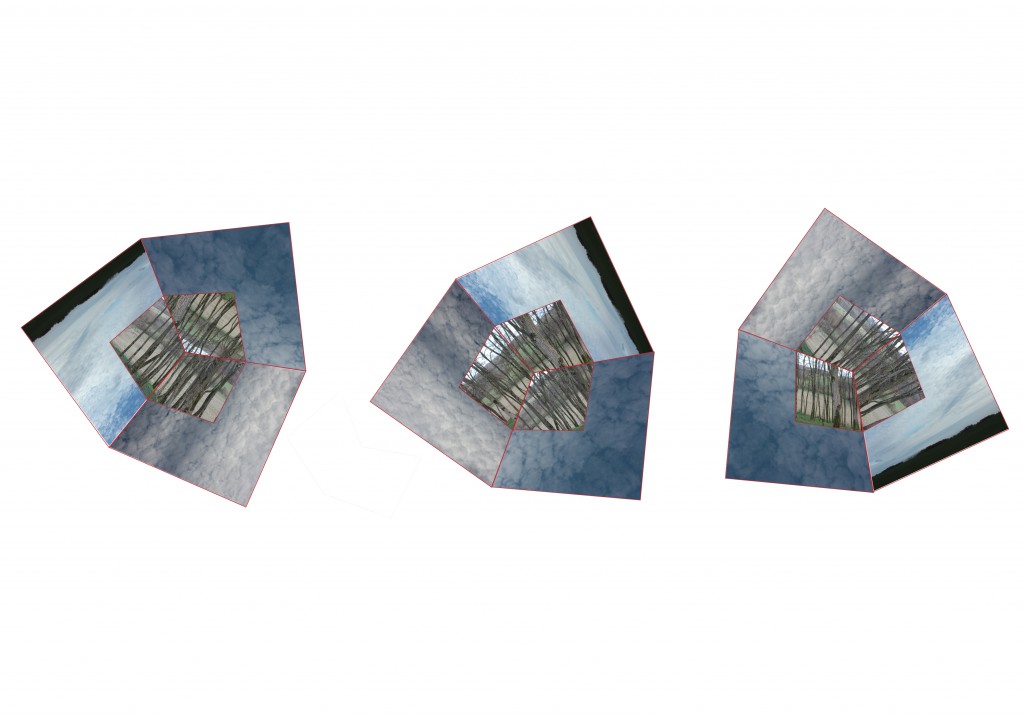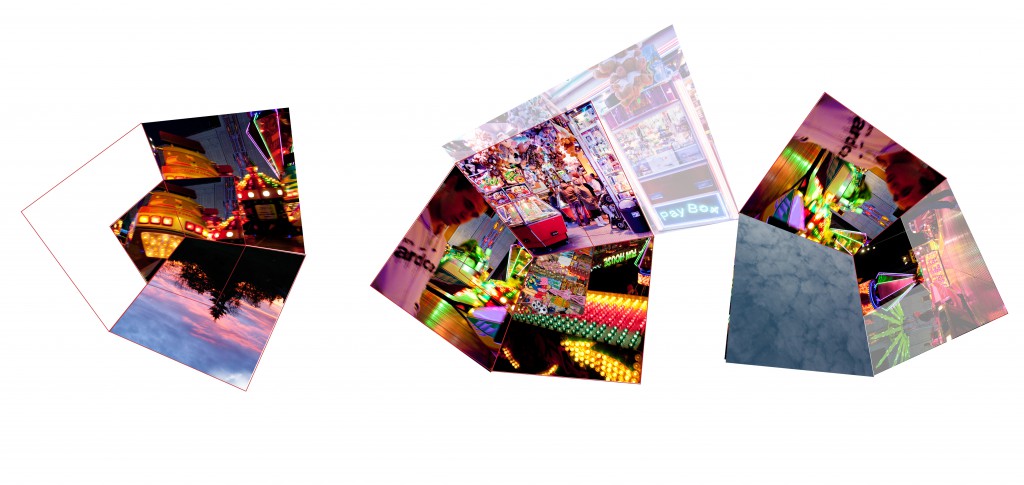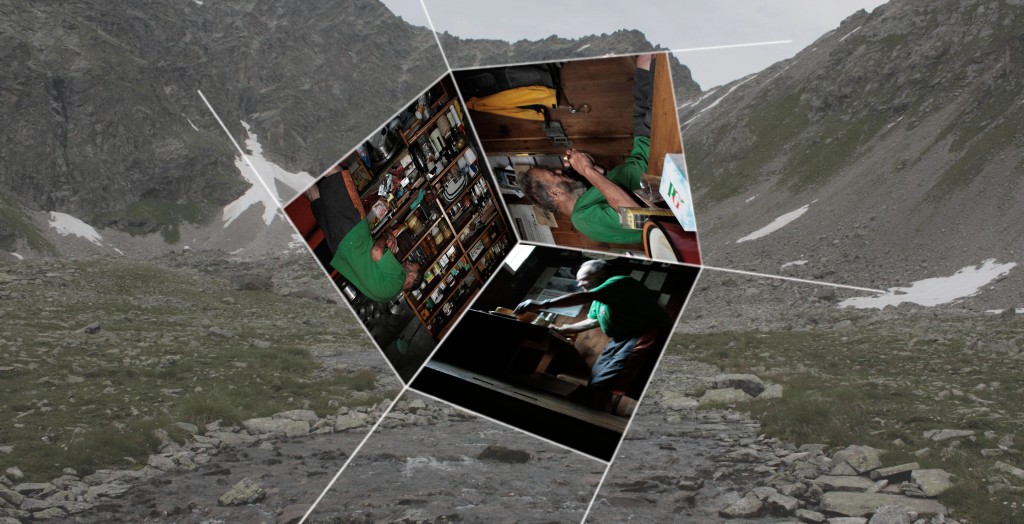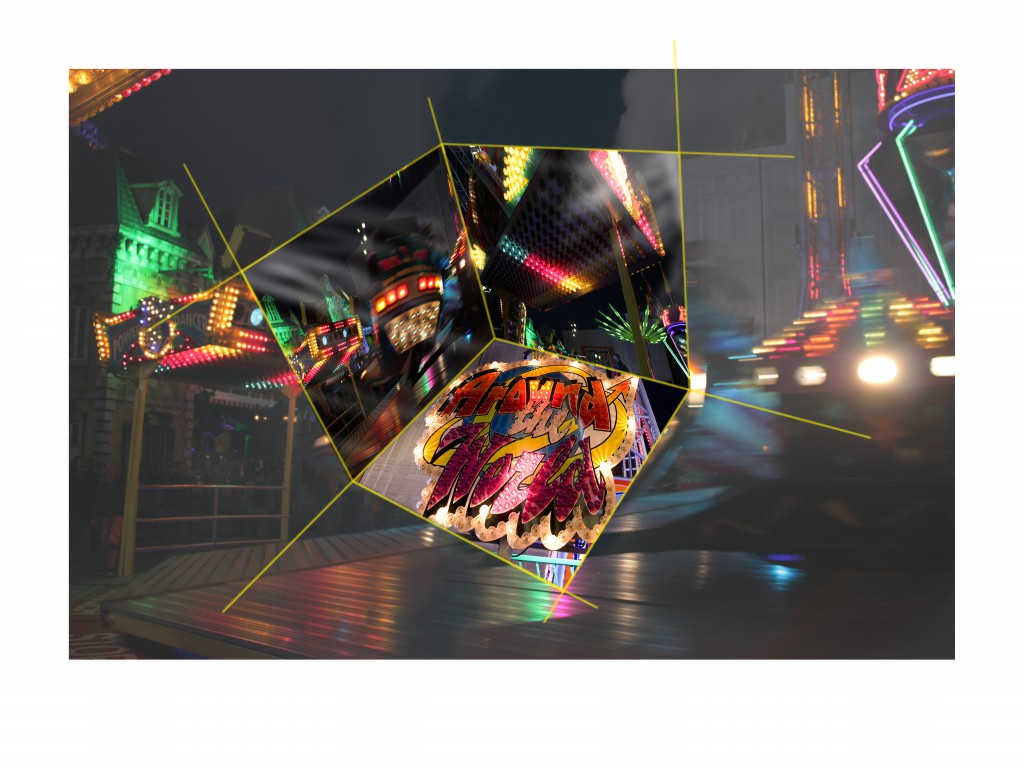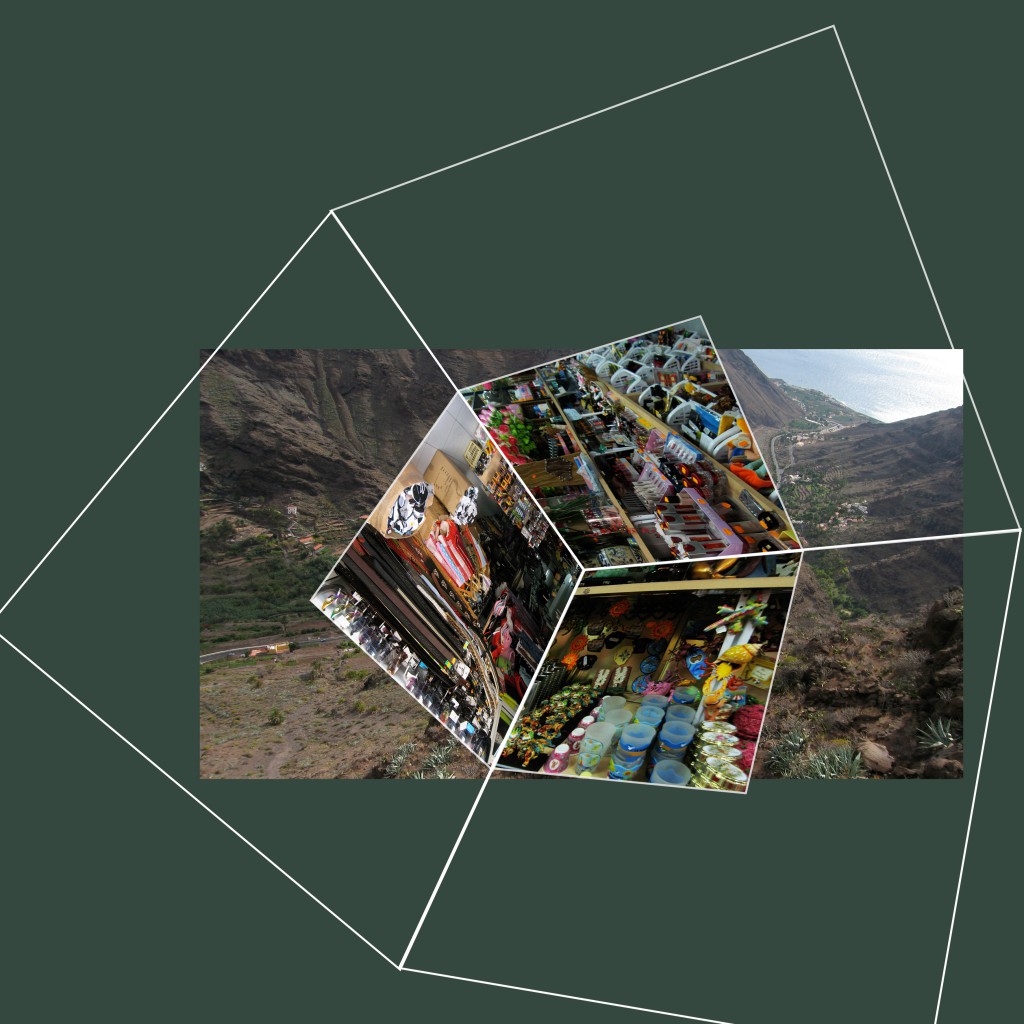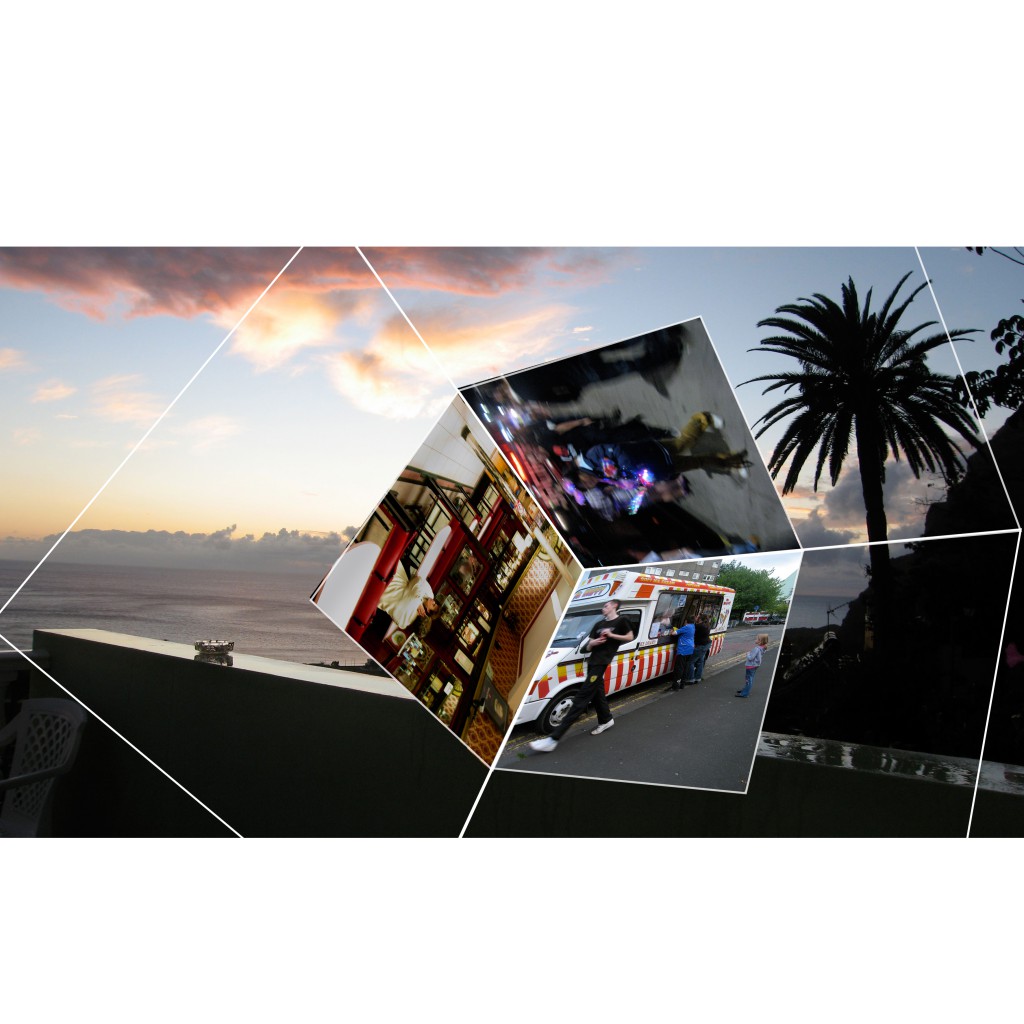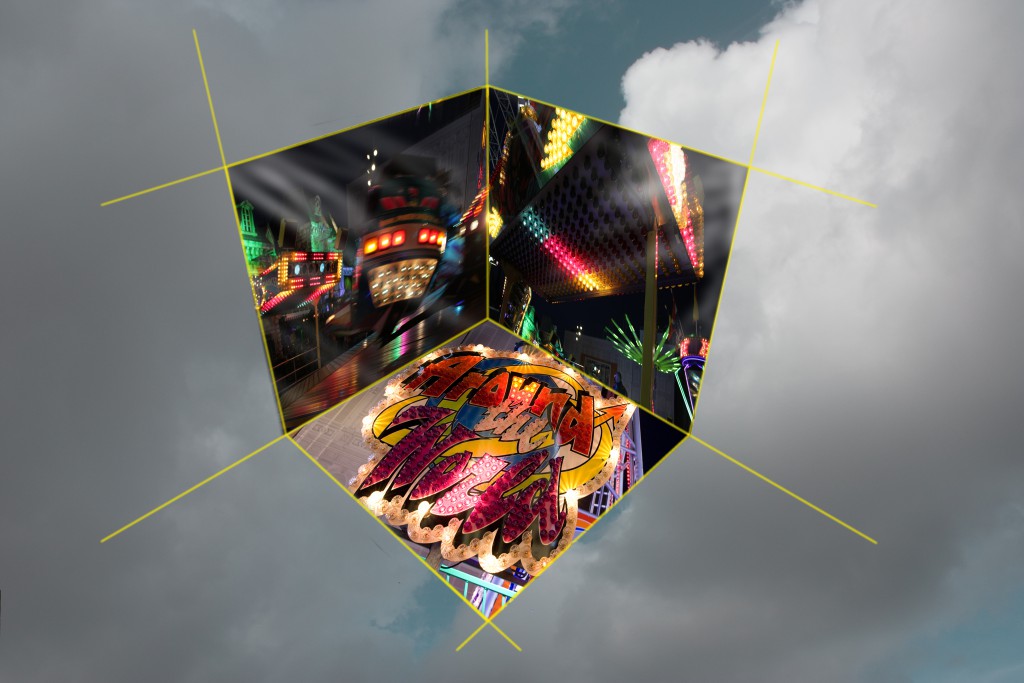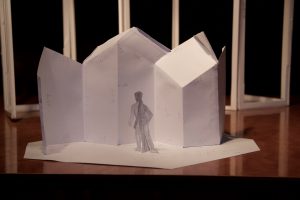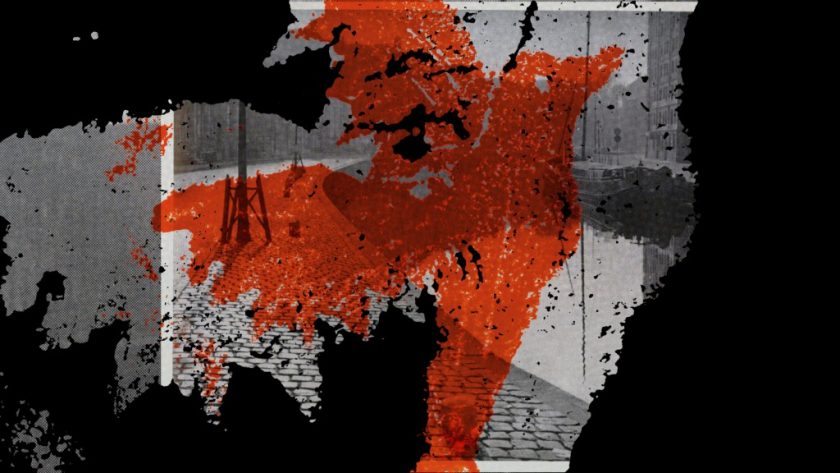
Author: Clare Mike

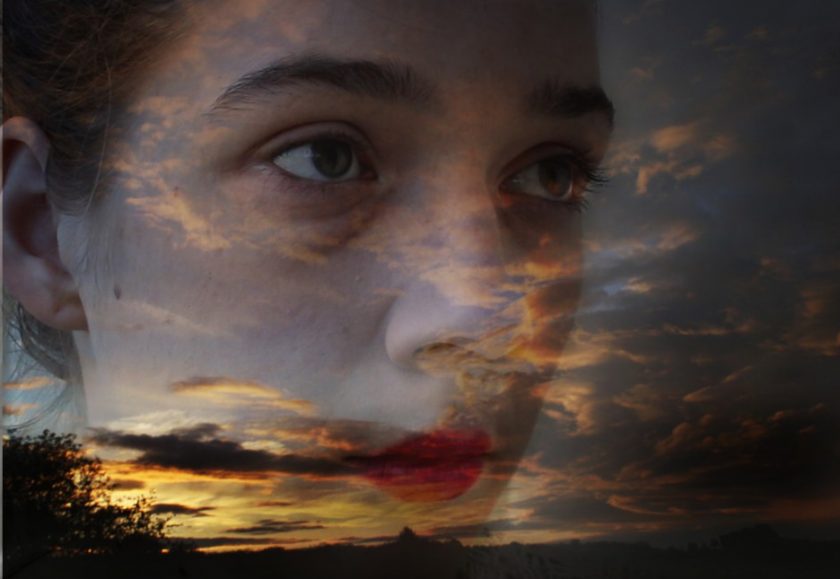
Children of the Earth
Children of the Earth is a series of photomontages and edited videos in which I combine the human body with landscapes, nature or other environments. That confrontation can take place both in the recording and in the editing and montage.

Benji’s Look over IJ, study for locus Ver West, part of the series Children of the Earth (1920 x 640 px)
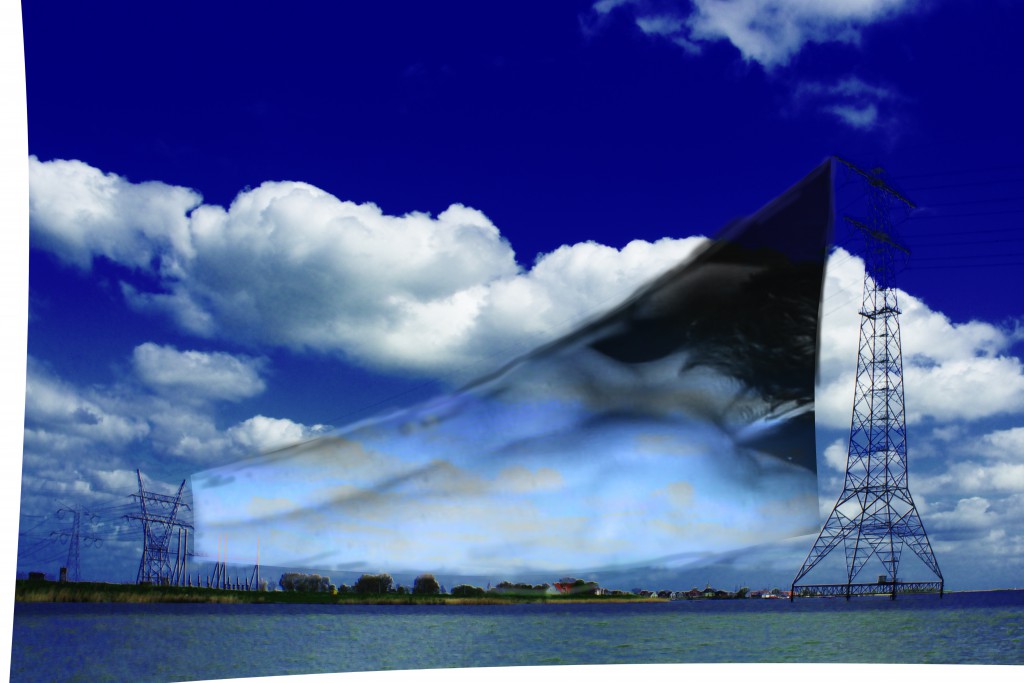
Jirin’s Back Over IJ, study for locus Ver West and part of the series Children of the Earth (5702 x 3802 px)
Benji’s Look over IJ, study for locus Ver West, from the series Children of the Earth (1920 x 640 px)
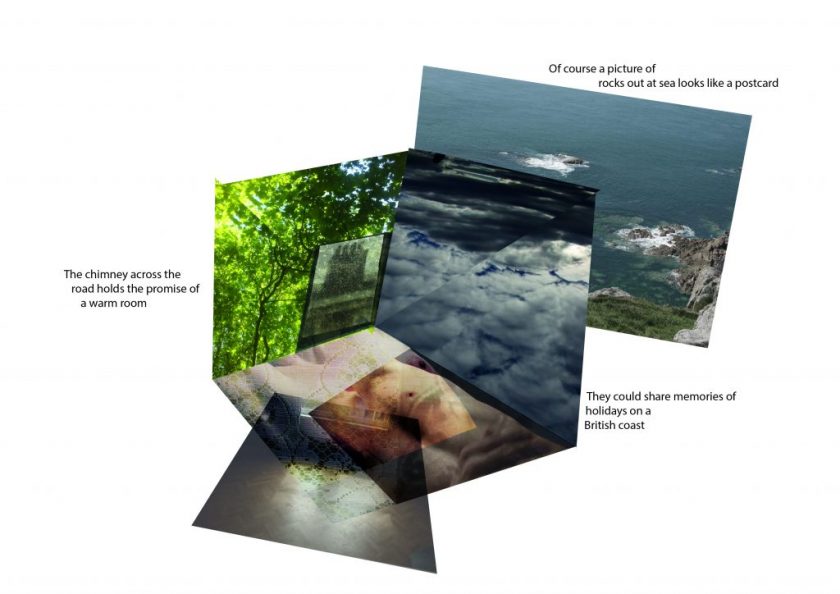
Hexagons
The six-sided hexagon is composed of three squares. The shape may be archetypal but how it is formed and used is not. It has depth and yet is flat at the same time.
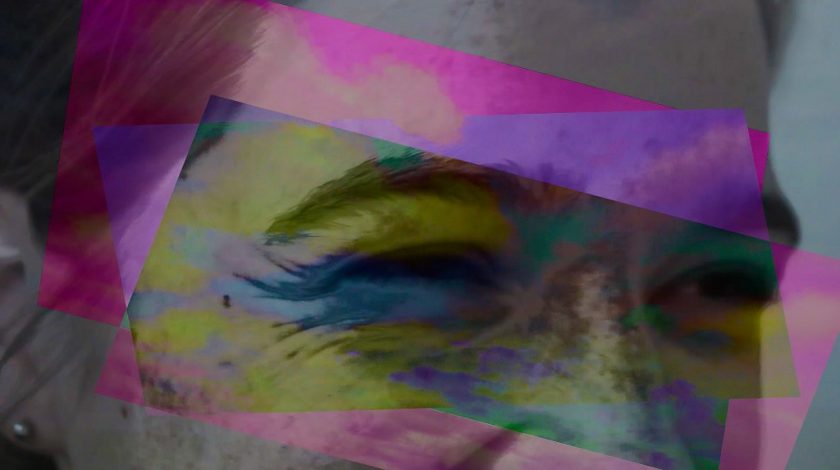
Eelste Meyma’s Mausoleum
Eelste Meyma’s Mausoleum
Anke Brouwer and Carel Kuitenbrouwer
2014-2016
Eelste Meyma’s Mausoleum consists of
Epitaph for Eelste Meyma
Composition by Anke Brouwer
for soprano, tenor, violin, recorder, lute and chimes.
(2014)
played by Super Librum, ensemble for medieval music
and
Eelste’s Crypt
Images by Carel fhm Kuitenbrouwer
(2016)
Epitaph for Eelste Meyma
The lyrics are by the humanist writer and thinker Rudolph Agricola (1444–1485).
They are a eulogy and epitaph for Eelste Meyma, an influential Frisian woman who was a patron to Agricola:
Look, this grave covers Eelste, who belonged to the De Meyma dynasty
now sent to the shadows by cruel death
(…)
She was rich in wealth, owned a house, built with strong walls, extensive lands many mornings in size.
The composition is performed by Super Librum, an ensemble for medieval music.
Anke dedicated the piece to her parents in 2014.
Eelste’s Crypt
is the title of the images that Carel fhm Kuitenbrouwer, made to accompany Anke’s composition when invited to do so by her. Eelste’s Crypt is based mainly on skyscapes, symbolizing the ephemeral continuity of human life, and geometric shapes, which stand at the same time for the strong and constructive personality of Eelste Meyma and the positive and touching words by Agricola, who says (for example):
More virtuous a woman Frisia has never produced, you see.
(…)
Whoever you may be, who comes here asking for help from the heavens on high (…) hear of people and all that’s theirs: what they are and how they are snatched away.
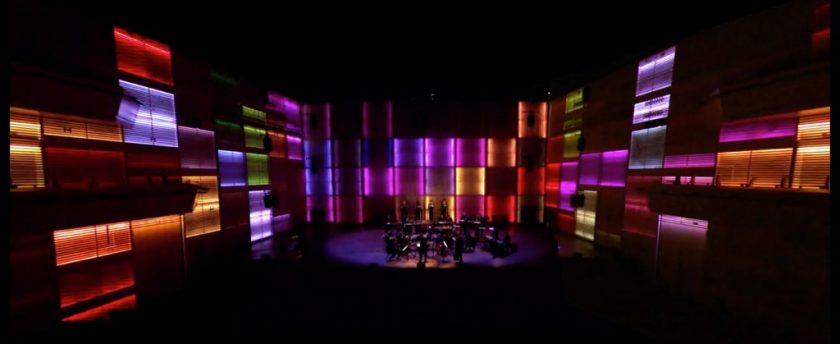
Tehillim Illuminated (2011)
Steve Reich’s masterpiece Tehillim (Psalms), with a light show by Carel Kuitenbrouwer. Muziekgebouw aan ‘t IJ, Amsterdam, 31 March 2011, as part of the World Minimal Music Festival.
For this performance, I designed and created a visual programme using the LEDs integrated into the walls of the auditorium. These acoustic walls have a light installation built in, consisting of two hundred panels, or cells, that can be instructed to take on any colour and intensity at any point in time.
Using Flash animation video and the e:cue lighting software, a synchronous light show was cued to the music by an operator during the live performance of the piece.
This enhanced performance of the very powerful minimal composition Tehillim was well received by the audience.
The video was compiled from several clips from three different positions. It was made using Adobe After Effects.
Full Credits:
Carel Kuitenbrouwer
presents
Tehillim Illuminated
Tehillim Illuminated was conceived and designed by Carel Kuitenbrouwer and performed on 31 March 2011 in the main concert hall of the Muziekgebouw aan ’t IJ, Amsterdam, as part of the World Minimal Music Festival 2011.
Tehillim: Steve Reich, 1981
Performers: ASKO|Schönberg and Synergy Vocals
Conductor: Clark Rundell
Light show (concept and design): Carel Kuitenbrouwer
Technical and creative support: Frank Daalder
Technical adviser: Rutger van Dijk, Rapenburg Plaza
LED wall operator: Annelies Vrieswijk
Special thanks to Willem Hering.
Tehillim Illuminated was made possible in part by the Amsterdam Fund for the Arts.
Video recording:
Director and cinematography: Willem Heshusius
Video editing: Anders and Pieter Veltkamp
The video recording was made possible in part by the online radio station Radio 4 Eigentijds and the VPRO broadcasting company.
Disclaimer
The sole purpose of making and distributing this video is to document and promote the work of Carel Kuitenbrouwer. The video is not intended for commercial purposes and may not under any circumstances be copied, distributed or sold, except with the express written permission of the creator, Carel Kuitenbrouwer.

Pretty How Town
The above video is an initial exploration of the poem by e.e. cummings, read here by the author. Animation by me.
Pretty How Town
an installation with live performances
Concept and Meaning
Pretty How Town is a multimedia installation with an associated programme. The artist Carel Kuitenbrouwer has designed a multimedia art project in which he wants to collaborate with fellow artists, musicians and poets. This artwork is an experience, in which visitors are invited to participate and reflect.
The project takes the poem anyone lived in a pretty how town by e.e. cummings as its theme. In this poem, cummings gives a sharp but affectionate description of the ‘ordinary man’ (and woman), aka the ‘little man’.
He compares the eternal cycle of the seasons with the lives of these people, who make up most of humanity and are born, grow up, marry, raise children, die and are buried in relative obscurity. In itself that’s a very common, familiar metaphor. But cummings has turned it into an enchanting poem. He puts quite ordinary words in unusual sequences, turning making the workaday into something special and magical. Cummings takes the insignificant and unremarkable and creates something that is poignant, exceptional and moving.
The installation Pretty How Town is a structure of walls and roofs, partly transparent and partly semi-transparent, made from expandable wire mesh. The simple geometry refers to the archetypes of the house, the street, the factory. One source of inspiration for me was the Utrecht of my childhood: the gallery-access flats between the Douwe Egberts factory and the dyke with the railway line, the neat terraced houses with their front gardens and net curtains.
Various video projectors project moving images onto the installation and there is a soundscape. Language plays a role through typography and the human voice. Images and sound play in a loop lasting about 20 minutes.
Visitors walk through the installation casting shadows, touch the screens and sit down on a bench to study the installation from a slight distance.
Sketch model of the installation
Background/Motivation
When I first heard the poem anyone lived in a pretty how town, I felt a shock of recognition. Cummings’ penetrating but tender picture describes the world I grew up in and from which I struggled to free myself. Cummings has reconciled me with that world; he sees the beauty in it and, in a masterly fashion, has transformed it into an ode that is both prosaic and romantic.
Cummings sings the praises of the winsome petit bourgeoisie in sleepy provincial towns, where ordinary people lead their ordinary lives, as enduring as the seasons. The events in their lives are just as eternal as the rain, sun, moon and stars.
(…)
Women and men(both little and small)
cared for anyone not at all
they sowed their isn’t they reaped their same
sun moon stars rain
(..)
I wanted to be different. But there was always that sneering sound, as if you are pronouncing a soft “ch” while your mouth is shut tight in a grin so that the air escapes through your nose. This is what I had to arm myself against.
But that struggle did give me the power and will to use my imagination. My imagination tells me that all is fair in art, as in love and war. That nothing is too small, too inconsequential to be portrayed. That precisely the small and the trifling have meaning.
I want to send my imagination soaring—and the visitor’s imagination too—so that I can make something wonderfully beautiful from grey, inconsequential mediocrity. To make the ordinary into something exceptional through my use of the imagination, to show the exceptional in the ordinary.
The specifics
Specifically, Pretty How Town consists of different layers and elements:
- An Environment, constructed from metres-high, semi-transparent planes
- onto which videos are projected
- more or less recognizable images
- typography: the text of the poem
- where the general public (and the performers when there)
- can wander around
- and sit on the benches surrounding the structure
- onto which videos are projected
- A Soundscape, which I have created in partnership with the jazz musician Ab Baars
- Poetry by cummings, in particular the titular poem
- Sounds, both natural and edited, in interplay/dialogue with the poetry
- Live Performances
- At set times, depending on the installation location
- Solos or combos
- Standing still, or moving in amongst the audience
The performers will be selected based on the affinity in their language and their ability to achieve a powerful expressiveness using simple means. Of course I will also look for an engagement with the subject matter: the desire to expand on the theme of the exceptional in the little people and the ordinary. The performances will be created through discussions and a collaborative process on an equal footing, as artistic input in the process and the result.
Above: Video with a simulation of the installation
Potential audience
Pretty How Town is suitable for many different locations. The general public could access the installation in a gallery, in a theatre hall or on site at a festival. There is a cycle of sound and images lasting about 20 minutes. Visitors can wander around the installation and sit down for a moment on one of the benches in the space, or on the installation itself where applicable. Musicians, singers and other performers will be invited to put on performances at certain times in the weekends or evenings, whether directed, in combination or solo, in sessions lasting 45 to 60 minutes.
Visitors will be immersed in the work in an experience that is pervasive, moving and at times confrontational. My installation can be a meeting point for artists and audience. It reduces the divide between the creators and the viewers: both are participants.
The installations I create offer venues and those in charge of programming a mix of fine art and theatre, and an innovative alternative approach to engaging the general public. They also offer organizers and festival and events programmers the opportunity to get even more benefit from the artists who will be attending anyway.
My work can serve as a laboratory and forum, a site for encounters, experimentation and debate involving not just artists, musicians, dancers and technical staff but also theatre-makers and event programming staff.
I also want my work to be a facility for amateur performers, young people and other target groups who can benefit from the shared experience and becoming involved in my art.
My work forms a tight cohesive whole both thematically and formally, and it touches people in an original way.
Which target groups could my work be relevant for?
In general:
- Fans of this multidisciplinary form of experience and installation art.
In particular:
- Visitors to the venue, whether or not they come specifically for the installation.
- Visitors who have come specifically for the performances.
- Professionals, students and amateurs in theatre, music, dance, mime, poetry and poetry readings.
- My own network and fan base (see too the section on social media).
- The networks of the musicians, dancers, dramatists, technical staff and other people involved in the work.
Setting it up and access
The installation Pretty How Town, designed and created by me, will have a good ‘return on investment’, both financially and in terms of production, because it can be used multiple times. The project can be set up for a longer period and can be displayed in various different locations and on various different occasions.
The installation is suitable for a variety of contexts. The installation itself is light and transportable. The equipment it uses is available in most theatres, or alternatively can be hired. No major investments are needed, nor does the installation take long to assemble and disassemble.
The installation’s lifespan is several years at least, and it can be modified to take account of the specific location and circumstances. It is also well suited for use at sites other than established theatres — for example, festivals, warehouses, school buildings and other public spaces.
With the right supervision, the installation can be used for a variety of different types of participant and target groups.
anyone lived in a pretty how town
(with up so floating many bells down)
spring summer autumn winter
he sang his didn’t he danced his did.
Women and men(both little and small)
cared for anyone not at all
they sowed their isn’t they reaped their same
sun moon stars rain
children guessed(but only a few
and down they forgot as up they grew
autumn winter spring summer)
that noone loved him more by more
when by now and tree by leaf
she laughed his joy she cried his grief
bird by snow and stir by still
anyone’s any was all to her
someones married their everyones
laughed their cryings and did their dance
(sleep wake hope and then)they
said their nevers they slept their dream
stars rain sun moon
(and only the snow can begin to explain
how children are apt to forget to remember
with up so floating many bells down)
one day anyone died i guess
(and noone stooped to kiss his face)
busy folk buried them side by side
little by little and was by was
all by all and deep by deep
and more by more they dream their sleep
noone and anyone earth by april
wish by spirit and if by yes.
Women and men(both dong and ding)
summer autumn winter spring
reaped their sowing and went their came
sun moon stars rain
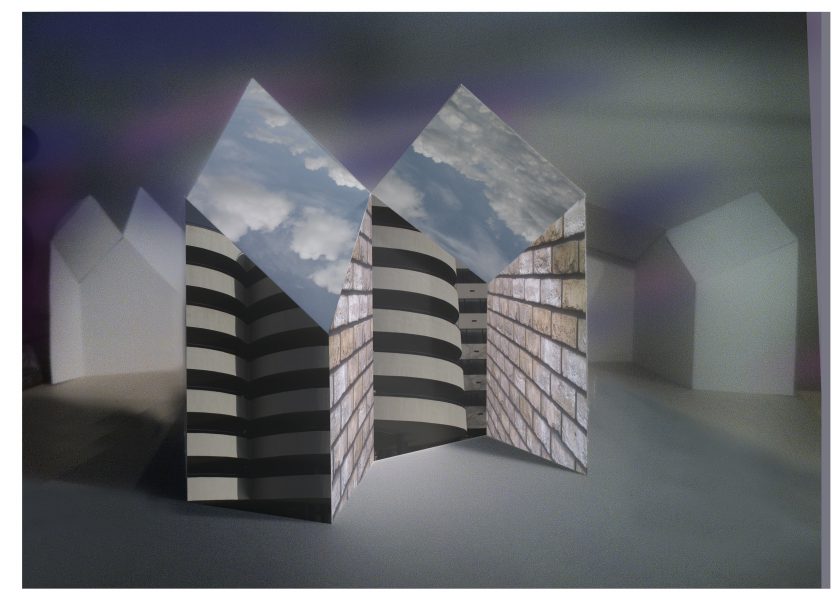
My Portfolio
My Work in Four Themes
This is an overview of work that has been created or is in progress in the fields of light design, scenography and multimedia.
I have organized the work into four themes, although there is inevitably some overlap between the themes.
Themes in My Work
- Environ/Man
- Environ/Man 0.5
- Pretty How Town
- Children of the Earth
- Hexagons
- Synchrome
- Synchronicity
- Eelste Meyma’s Mausoleum
- Colour Sound Signal
- Tehillim Illuminated
- Sulphur, Wax & Sugar
- Anamorphology
- Would You Wonder Off
- Wygiswysee (what you get is what you see)
- Spatial Cinema
- The Family Reunion
- Now The Stew How Saw
¶
Theme 1.
Environ/Man
Man is the (self-appointed) steward of the globe and at the same time dependent on nature and its resources. His insatiable hunger for economic growth and expanding power creates a paradox between this stewardship and the exhaustion of the planet’s reserves and resources.
The theme investigates similarities between the human body and landscapes. It provides an integrated multimedia experience for visitors to the installations.
Below are five projects that belong to this theme. Clicking on the title above will take you to a collection of entries about this theme. Clicking on any of the project titles below will show the different entries on this website relevant to that specific project.
Multimedia installation with live music and performances, life-sized objects, video and sound. The installation can be placed in a theatre or a multifunctional venue. Local professional artists, amateurs or students will collaborate in experiments with space, image and sound. This work is in progress.
Click here to see the “aftermovie” of the first try-out in November 2015.
- Pretty How Town
Installation, occasionally with live performances, based on a poem by e.e. cummings. Space, shape, speech, sound, images.
A series of photomontages combining human bodies with landscapes and cityscapes, water, skies, leaves. Click on the title above to see some examples. The images can be printed at approximately 35 by 50 centimetres, exhibited and sold.
¶
A series of graphics, combining geometric shapes and photographic images. These images can also be printed, exhibited and sold.
A tent made of three or four big semi-transparent projection screens, in the middle one or two Chinese poles about six metres high, on which my son Benjamin will perform; projections of abstract and edited live imagery. Plans in progress.
¶
Theme 2.
Synchronicity
The challenge is to allow visitors/participants to experience art through several senses, and to surprise them with rich sensory stimulation.
Synchronicity and synergy of sound/music and imagery/colour; similarities, mutual enhancement, multi-sensory experiences.
Eelste Meyma’s Mausoleum is
Epitaph for Eelste Meyma
Composition: Anke Brouwer
for soprano, tenor, violin, recorder, lute and chimes.
(2014)
played by Super Librum, ensemble for medieval music
and
Eelste’s Crypt
Images by Carel fhm Kuitenbrouwer
(2016)
- Coloursoundsignal
Coloursoundsignal (Kleurengeluidsignaal) is a composite word made up of colour, sound and signal that was invented by H. N. Werkman, a Dutch printer and graphic artist (1882-1945). I chose it as the title of a work for choir, symphony orchestra, soundscape and video, created in collaboration with Anke Brouwer and commissioned by Kamerfilharmonie Der Aa, Groningen, Netherlands.
Light show programmed for the LED walls of the concert hall Muziekgebouw aan ’t IJ in Amsterdam to accompany the performance of Steve Reich’s pivotal piece Tehillim (Psalms), from 1981. In collaboration with Steve Reich, ASKO|Schönberg Ensemble, Frank Daalder, Clive Rundell.
Sulphur, Wax & Sugar, a spatial light/music/sound spectacle in the concert hall Muziekgebouw aan ‘t IJ in Amsterdam. Collaboration with composers Anke Brouwer and Martijn Padding, ASKO|Schönberg Ensemble, Holland Festival, Muziekgebouw a/t IJ.
Theme 3.
Anamorphology
What you see is not always what you see. My videos and graphics contain layers and facilitate multiple interpretations. I extend this ‘principle’ of surprise and wonder into 3D-space. Objects are placed in space, the perspective is distorted, the viewer is seduced into imagining what is not there.
A walk through a park or wood along a trail of objects in anamorphic arrangements: geometric shapes, frames, planes with distorted perspective. In parts big and strong enough to carry visitors (children!).
The work is intended for public spaces that temporarily or permanently stage artworks, such as parks, buildings and festivals. In development, proposals available.
Words in space; anamorphosis with texts, lines, words, letters, calligraphy.
The idea of ‘looking beyond’, formulated poetically and presented spatially. About ten lines that I wrote myself, split up into parts, sometimes words, panels or signs on trees, branches, posts.
This work is also intended for a public or semi-public space, where people wander and wonder what the words mean, until they reach a spot from where it all comes clear — the puzzle fits. And yet it doesn’t quite.
I made several sketches for big pieces in a public space. This is one example — more can be found on the rest of my site.
Above: a dynamic typographic interpretation of cummings’ poem.
Pretty How Town (working title) is an installation based on the poem by e.e. cummings any one lived in a pretty how town. The video above is a first exploration. A spatial/environmental rendering is in preparation.
Cummings describes and analyses the petty lives of ordinary people poignantly and at the same time affectionately; he makes the ordinary special.
Collaboration with Ab Baars (clarinets/saxes/shakuhachis) and Martin Reints (poet/translator).
Project plan under construction, sketches available.
¶
Theme 4.
Spatial Cinema
Spatial Cinema deals with archetypical narratives such as the Western film or plays about family relations.
It involves space, performers, objects, video and sound. The settings are more or less those of a theatrical play, although the classic divisions between stage and auditorium and between audience and performers are also under investigation within this theme.
Semi-abstract, semi-narrative, atmospheric, metaphoric, symbolic.
- The Family Reunion
Old social patterns in nuclear families, originating in the childhood and puberty of the siblings and early ‘beginners’ parenthood, persist through the adult lives of the siblings and re-emerge in family gatherings. Or, conversely, family events are prompt the regeneration of feelings of unconditional love and affection.
What would the outcome be if my children, both active in the performing arts, come together in a creative process with their parents, both creative entrepreneurs?
Collaboration with Yinka Kuitenbrouwer, independent actor/theatre maker in Ghent,
Benjamin Kuitenbrouwer, alias Monki Business, Chinese Pole acrobat, and
Ange Wieberdink, producer, filmmaker.
Concepts and plans are in collaborative development.
Abstract music theatre piece (aka spatial film or abstract opera) in five acts, five musicians, five dancers. Objects, dynamic and spatial imagery, lights, video.
Loosely based on the great Western How The West Was Won.
Central theme: (Western) Man’s insatiable drive towards pioneering, exploitation and expansion; the paradoxical side of that drive: the destruction of virgin nature and the creation of scarcity and inequality, migration, conflicts.
Plans in development.
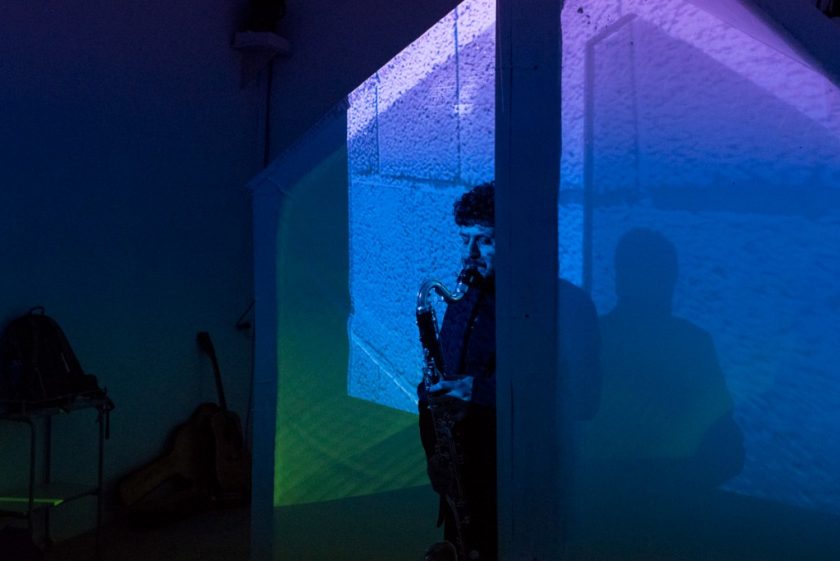
Environ/Man 0.5 in 3’21”
Friday 20 November: opening, with performances by Anke Brouwer, who composed the soundscape, Ab Baars, Wiek Hijmans, Elise Lorraine, Martin Reints and others.
About twenty hours in less than three and a half minutes.
Saturday: open for people to wander through from 12 noon. Couples and families, friends and people out walking on their own come in, some stay a while. More performances at the end of the day: poets, actors, a Canadian friend over from Berlin, the project’s co-initiator Oğuz Büyükberber, Peter van Os and Marc Winder.
Sunday: another afternoon of admirers, questioners, viewers, listeners. From 4pm singing, playing, meeting and conversing by Elise, Jula, Saskia, Julia, Martin, Bart, and people who happened to be there.
A very instructive and inspiring event.
Thanks to everyone who came.
For a Dutch review of Environ/Man 0.5, click here
<Separate file>
Environ/Man Project Plan (English)
Click on the video below to get an explanation of Environ/Man in less than two minutes
For the elaborate project plan please scroll down.
Table of Contents
- Summary: A total experience for visitors
- Synergy & Cooperation
- Podiums and Audiences
- Concretely
- Imagery
- Living People
- Reaching audiences and having an impact
- Realization and Planning
- Summary: Total involvement of the public
Environ/Man is a multimedia installation in which live performances take place. The content of the installation is based on the following concept: Environ/Man deals with how man modifies his surroundings to suit his needs and is then forced to adapt to those same surroundings — pristine nature, cultivated lands and the urban environment. Man depends on Nature for his survival, yet he still persists in threatening and destroying it. He turns Paradise on Earth into a barren, infertile desert.
While the megalopolis seems to be the only place for people to survive, man turns his cities into inhuman concrete jungles, where only the values of a technocratic free market prevail.
Three large objects dominate the installation Environ/Man, I call them loci, places. Moving images, projected by several video projectors, are displayed on these objects. Both visitors and performers pass through these projections, thus creating a simple form of interaction. More sophisticated forms of interaction are under investigation.
Ɛde
is — in principle — a heavenly place, a pastoral Arcadia, where man, animals and nature live in harmony. In principle, because this paradise is under constant threat, from development, urbanization, progress.
Visitors can take a seat on Ɛde.
nirgend
is an angular architectural shape, made of semi-transparent stretch fabric. Visitors walk through the beamed video images, touch the surface of nirgend, thus changing their own experience and becoming part of the installation.
nirgend refers to the impersonal megacity and suburbs. The —visual and musical — rhythm of this locus is energetic, nervous.
Ver West
refers to the horizon in the landscape that is Environ/Man. It is also a reference to the wide cinema screen. Its projection ‘spills’ onto the walls and floor around it. The audience can walk around it to experience the spatial projection.
Thematically, Ver West stands for unknown and far-off lands, to be colonized — and in the process natural habitats and cultures are inevitably destroyed.
These loci are all lit by lights and moving abstract and semi-abstract images. Anke Brouwer created a soundscape for Environ/Man in collaboration with guitarist Kees Spijker, trumpet player/singer Ruth Becker and cellist Tjakina Oosting.
Schematic sketch of the spatial installation Environ/Man
What makes Environ/Man unique?
As far as the ‘content’ goes, I am fascinated and puzzled by the way human kindness relates to its surroundings, the environments it lives in. Man modifies and adjusts nature to his own purposes and is then forced to adapt to the changing environment. With his ‘natural’ tendency to always explore new areas and horizons, he constantly threatens the very nature on which he depends. And he turns cities into concrete jungles.
Artistically my mission is the Gesamtkunstwerk, the unification of all possible media to create a total, comprehensive experience for the audience. Environ/Man is a station on the road to achieving this mission. It takes the form of an installation in which different disciplines are in dialogue. It is my ambition to create an experience that involves and immerses the public. This experience is abstract and meaningful, but beyond words.
Environ/Man has a clear, given shape. The installation can be visited as a ‘standalone’ or in a gallery or museum.
The installation can also be the venue for different kinds of input, such as live music, dance, movement, poetry readings and singing. It can be adapted to suit the context and the performers, who could be professionals, amateurs or students. The visitor/spectator also plays an integral part in the installation.
This social and interdisciplinary aspect — sharing experiences and knowledge — is important to me.
The project is a laboratory and platform that could be developed over several years. For visitors it will be an involving, engulfing experience. Though technically sophisticated, the primary goal is to move people.
nirgend. Photomontage with scale model and figures 1:6
Environ/Man is a cohesive, self-contained project as well as a step towards what I like to call ‘abstract music theatre’ or ‘spatial cinema’.
- Synergy and collaboration
Environ/Man is an open and flexible project that delivers artistic synergy. The project can be placed in various contexts. It is a laboratory for interdisciplinary collaboration. The input of performing and creative artists is crucial.
The installation is light and transportable. The required technical equipment is available in most theatres or can easily be hired. With appropriate support, the project can work with a variety of participants, both amateur and professional.
- Podiums and Audiences
Environ/Man is a meeting place for performers and the general public. It reduces the distance and distinction between maker and spectator. Both are participants.
How this will work out in practice will become clear during the first experimental presentation of Environ/Man, on 20-22 November, in WG Kunst as part of the first ARTWEST.
The first fully fledged presentation of Environ/Man will be in Ostadetheater Amsterdam, as part of a weekend devoted to the fusion of art and theatre, 26-28 February 2016.
Talks are ongoing with Codarts Rotterdam, a school for music, music theatre and circus arts, about an interdisciplinary project week centring on Environ/Man in April 2016.
Negotiations are also underway with the international festival Operadagen Rotterdam 2016 for song, opera and music theatre, in May 2016.
- Specifics
Environ/Man can be installed in a small theatre room or art gallery (ideally about 12 x 18 m). The space has an even floor and enough space around the objects for visitors to wander around.
Three large objects (for now) are placed in the installation. Images are projected onto these three ‘loci’ by two to four projectors and some spotlights.
The installation includes a soundscape.
The option is being investigated of techniques such as randomization, sensory reactions to movement and the application of mist and smells.
The creative process can be followed through this blog.
- Imagery
Here follows a more extensive explanation in words and images — and a few sound samples — of the content of Environ/Man, in particular the three large objects.
nirgend
is a reaction to the impersonal, inhuman, inhospitable environment of the megalopolis, but also the city’s edges, the suburbs.
This environment has a nervous, even nerve-racking pace that is mechanical and technical. It is an environment created by man, in which people can barely live.
Below: a short video of the design, execution and imagery of the locus nirgend.
nirgend is an architectural shape made of semi-transparent material, about three and a half metres in height and width. Several video projectors project onto nirgend. The images were shot mainly in urban areas, but also along highways and railways. The projections overlap partly, alter the perspective and distort it visually.
Visitors move around nirgend, cast shadows and alter their own perception.
The soundscape is by the composer Anke Brouwer and guitarist Kees Spijker.
Below: two video fragments for the locus nirgend.
This material will be further elaborated, mixed and repeated.
Above: short clip of video for nirgend: Four Fast Lanes Times Two 69
Below: fragment of investigatory sketches into horizontally overlapping video:
Destination Amsterdam Central 2880*1080 150
Above: video fragment that will be used in nirgend : HoneyComb HighWays 130
Ɛde
Ɛde is an Arcadian, heavenly place. That is, in principle. At first sight the shape seems ‘nice’, inviting. The images are quiet, soft and natural: foliage, trees, fields, skies, water flowing.
But this paradise is under constant threat. At its edges appear pylons for power cables, wind turbines, the city’s edges, industrial areas.
Below: an impression of this locus.
Now and then a human shape appears, a vaguely recognizable referrence to naked, virginal man.
In concrete terms, Ɛde is an island-like shape measuring about two to three metres across. Visitors can go on it and change the projection.
This video clip Molino sets on Ede gives an impression of Ede in the form of the plaster model, video and a beautiful clarinet theme by Oğuz Büyükberber.
Coing en Fleurs (below) is an excerpt from a longer video, to be elaborated on for the locus Ɛde.
This video, Read Beeches 1280 720 80, will, in one form or another, also be part of the locus Ede
The montage below, Etang des Copins, gives a first impression of how landscape, nature and the human body will be integrated in Environ/Man.
Etang des Copins, for Ede
Ver West
is a wide, concave screen made from a gauzy fabric. Pylons on either side refer to telegraph poles and high-voltage pylons.
Ver West will have imagery about the landscape, both natural and developed areas. Ver West is the horizon that hides the unknown, beyond which lies the Promised Land. Colonizing this unknown inevitably brings violence and destruction. The human body also plays a part here.
Anke Brouwer has created the soundscape for Ver West, in collaboration with singer Ruth Becker.
Below: a simulation of the locus Ver West using a 1:6 scale model with a video of about six minutes. The aim is to have a six-metres-wide object with a video of about twenty minutes long.
Ver West. Study
Alternative view of Environ/Man.
- Living People
An important aspect of Environ/Man is collaboration with other artists/performers. It is an innovating environment in which additional contributions — vocal, musical, textual — are essential. This makes the project a laboratory.
-
- Sharing Knowledge and Experience
Through collaboration with artists in different disciplines, I would like to contribute to a common body of knowledge regarding synchronicity, synergy and the creation of Gesamtkunstwerke. Of course I am already sharing these experiences through social media and using them in presentations.
-
- Artistic Collaborators
At present, the following people are artistically involved in Environ/Man:
Ab Baars, jazz musician (20 Nov.)
Ruth Becker, vocals and trumpet, collaboration on the soundscape, Amsterdam
Anke Brouwer, Amstelveen, composed the soundscape
Oğuz Büyükberber, clarinet, bass clarinet, electronic composer, Amsterdam (20 Nov.?, 22 Nov.)
Laura Carmichael, clarinet, bass clarinet, Amsterdam (22 Nov.)
David Fischer, construction and technical advice (20-22 Nov.)
Monica Germino, (electric) violins, Amsterdam, Yale
David Eggert, cello, Berlin (21 Nov.)
Wiek Hijmans, electric guitar, Amsterdam (22 Nov.)
Benjamin Kuitenbrouwer, circus artist (technical assistance 20-22 Nov.)
Yinka Kuitenbrouwer, actress/theatre maker
Elise Lorraine, vocals, accordion, Amsterdam, London (20-22 Nov.)
Peerke Malschaert, theatre maker (20-22 Nov.)
Jirin Meilgaard, acrobat
Tjakina Oosting, cello, Amsterdam, soundscape
Peter van Os, accordion, trombone, composer, Amsterdam (22-22 Nov?)
Martin Reints, poet, Amsterdam, Brantgum (20-22 Nov?)
Ruby Soliman, actress, songwriter, Rotterdam (20-22 Nov?)
Tanja Sap, visual artist
Kees Spijker, guitars and co-maker of the soundscape, Amsterdam (20 Nov., 22 Nov?)
Bart Top, poet, Amsterdam (20-22 Nov.)
Inez Verhille, dancer, Ghent (20-22 Nov.)
Marc Winder, sax, Amsterdam (20-22 Nov?)
-
- Collaborators on the content, technicalities and advices
Guy Coolen, Transparant & Operadagen Rotterdam, advice and negotiations for programming Operadagen 2016
Frank Daalder, artist, Amsterdam, advice
Rutger van Dijk, Rapenburg Plaza, technical advice
Marion Beltman, business and marketing advice
Willem Hering, formerly ASKO|Schönberg and Ictus, now Veenfabriek, advice
Willem Heshusius, camera (and lighting), studio and exterior.
Rozé Leemput, WG Kunst, location, advice
Jaap Oostveen, technical advice
Jelle Oppers, BeamSystems, advice and supply of equipment
Hilde Teuchies, Vlaams Theater Instituut, Brussels, advice
Mark Walraven, Ostade A’dam, advice and programming, February 2016
-
- People with whom talks are ongoing on different aspects
Alida Dors, creative leader, dance company Backbone
Joshua van ‘t Hoff, filmmaker, discussions about ‘The Making of Environ/Man’
Back to Table of Contents
- Reaching the public and creating an impact
Ongoing activities in communication and marketing:
Reporting the project’s progress, sketches and models, on this website, Facebook, Vimeo, YouTube.
A ‘The Making Of’ by Joshua van ‘t Hoff
Collaboration with partners and venues (ARTWEST, Codarts, Ostadetheater WG Kunst and Operadagen)
Facebook: 325 friends
Linkedin: 436 contacts
YouTube: 76 subscribers and 88,578 views
-
- Why organizations should cooperate with Environ/Man
Environ/Man is a laboratory and a forum, a place for encounters, experimentation and debate for artists, technicians and programmers.
The project offers venues and programmers a fusion between sculptural art and theatre and an innovative way to engage audiences.
It also lets organizers and programmers of festivals and other events create added value with artists already participating in the event.
In the future, Environ/Man will also be available for amateur artists, students and other groups, such as the Codarts school of performing arts.
Research
Environ/Man investigates several artistic problems, such as:
-
- Image and sound mutually influence each other in the experience of the beholder.
- Question: how can image, sound and space play equally valuable, yet abstract roles in the experience of visitors to Environ/Man?
- Meaning comes about in the encounter between the maker and the public in and around the visible, audible and tangible reality of the installation.
- Question: How to make this encounter between maker and audience more meaningful, more concrete and of influence on the reality of the installation?
- Synergy between different media can be brought about in various ways and on several levels: through direct, automatic interaction, simultaneity or synchronicity, live interaction, improvisation, in programmes scores and on a conceptual level.
- Question: how to make effective choices in the framework of Environ/Man?
In regard to the above, there are numerous technical and production issues to resolve, such as:
- Is it possible to project onto mist?
-
- Can sound be manipulated by shadows occurring in the projections?
- Can performers be supplied with portable sound amplification?
- Can a projector follow a moving dancer?
- Can live (streaming) video be used in Environ/Man?
- Can we give the Environ/Man’s visitor’s nose something to do as well?
- Realization and Planning
A very important step will be taken in November with the first experimental presentation in WG Kunst, Amsterdam, 20-22 November 2015.
Environ/Man has an option for 26-28 February 2016 in Ostadetheater Amsterdam. Details will follow.
Discussions continue with Codarts and Operadagen concerning collaboration in April/May 2016.
Applications for residencies and funding are underway.

Sulphur, Wax & Sugar
“With the spectacular Sulphur, Wax & Sugar, with music by Anke Brouwer and Martijn Padding, graphic artist Carel Kuitenbrouwer became the first person to finally make proper use of the [contemporary music venue] Muziekgebouw’s light wall, with a vertiginous myriad of colours that referred to the oeuvre of Andriessen.”
Jochem Valkenburg, NRC Handelsblad, Monday 8 June 2009
The project that garnered this praise and that I initiated has now been published on Vimeo, the platform that lets filmmakers and artists make their creative work publically available. A DVD of the work was also produced (in a limited edition).
Another review:
“Brief compositions by friends and former pupils were on the one hand rather amateurish but they also demonstrated the will and the guts to keep on experimenting and exploring. The multimedia performance of Sulphur, Wax & Sugar by the artist Carel Kuitenbrouwer and the two composers Brouwer/Padding was a convincing example of this.”
Kees Arntzen, Trouw, 8 June 2009
A revised version of Sulphur, Wax & Sugar was performed again on 27 August 2009, during the evening event when the Amsterdam Fund for the Arts handed out its annual awards. This performance was described by Dutch newspaper Het Parool as “An audio-visual fairground for the advanced culture vulture who likes their culture with a capital ‘C’. Simply because it’s possible. And perhaps to show the crème de la crème of the Amsterdam art world what the building can offer. And let’s be honest: that is impressive.”
For more information about the event, see http://www.amsterdamsfondsvoordekunst.nl/organisatie.php?page=1&id=5.
Collaborating on Sulphur, Wax & Sugar: composer Anke Brouwer, mayor of Amsterdam Job Cohen, Frank Daalder, Willem Hering, composer Martijn Padding, ASKO|Schönberg Ensemble conducted by Jurjen Hempel, Muziekgebouw aan het IJ and Holland Festival.
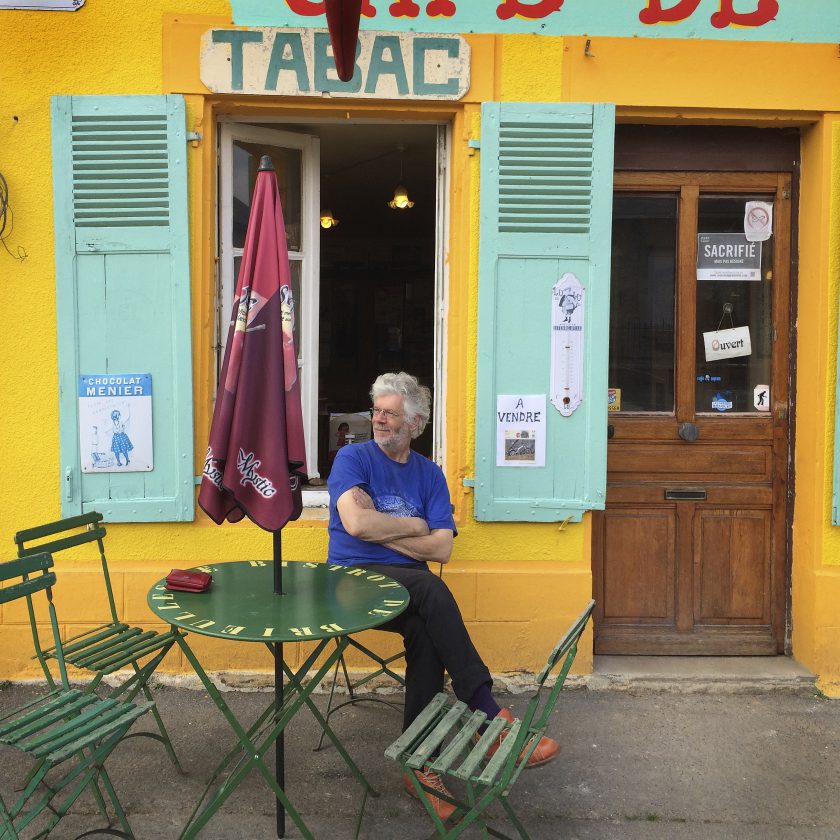
My Resumé
Carel fhm Kuitenbrouwer
Born 1953, lives and works in Amsterdam, the Netherlands and in Champigneulle, France.
Graphic artist and artisan—in a broad sense, from typography and infographics to photography and videography.
Writer—journalism, criticism, poetry.
Husband to Ange Wieberdink, father of two adult children.
Speaks German and Spanish at beginner’s level, French proficiently and English almost fluently.
Curriculum vitae
Autonomous Work and Projects in Commission
(in addition to part-time employment)
2016
Eelste Meyma’s Crypt
Video images to accompany a work by Anke Brouwer for the medieval music ensemble Super Librum (2014).
Integral video, sound and some liner notes: Eelste Meyma’s Mausoleum.
2015
Environ/Man 0.5
Spatial and multimedia installation with live performances. Collaboration with Anke Brouwer, Ab Baars, David Eggert, Elise Lorraine and many others.
First public showing in WG Kunst, as part of ARTWEST, November 2015.
Documentation: Environ/Man 0.5 “aftermovie”.
Coloursoundsignal
Composition for choir, orchestra, soundscape and video.
Collaboration with Anke Brouwer, composer. Commissioned by Kamerfilharmonie De Aa, Groningen.
Première 7 and 8 November 2015, Leens and Groningen.
Documentation: Coloursoundsignal, The Video.
2013
From Brooklyn to Berlin
Spatial and visual accompaniment to concert by Kaleidoskop Ensemble (Berlin) and Lee Ranaldo (Brooklyn).
Commissioned by Holland Festival and Kaleidoskop Ensemble.
Muziekgebouw aan ‘t IJ, Amsterdam, 14 June 2013.
No documentation available as yet.
2011
Tehillim Illuminated
Spatial and visual accompaniment to Tehillim (Steve Reich, 1981). Collaboration with ASKO|Schönberg, Synergy Vocals, World Minimal Music Festival 2011.
Muziekgebouw aan ’t IJ, Amsterdam, April 2011.
My initiative was funded by the Amsterdam Foundation for the Arts (AFK).
Documentation in words and images: Tehillim Illuminated on Vimeo.
2009
Sulphur, Wax & Sugar
Lights, sounds and live music spectacle to celebrate composer Louis Andriessen’s 70th birthday. Collaboration with composers Martijn Padding and Anke Brouwer, ASKO|Schönberg Ensemble, Holland Festival.
Muziekgebouw aan ’t IJ, Amsterdam, June 2009.
My initiative and concept was supported by AFK.
Documentation: Sulphur, Wax & Sugar on Vimeo.
Open Source Amsterdam
Open Air Art Manifestation in Amsterdam Bijlmer (9 May – 11 July 2009).
Author of print and online catalogue.
2008
Stedelijk Museum Schiedam
CoBra 60 years, The Colour of Liberty (13 September – 30 November 2008).
Exhibition texts about the lenders of paintings and sculptures.
2005
TheaterMuseum Amsterdam
Kikker & Co
Lettering for exhibition about puppet theatre.
2002-2003
Medisch Vandaag, Utrecht
Consultant in restyling of fortnightly tabloid magazine for the medical and paramedical sector.
2002
Stichting Best Verzorgde Boeken, Amsterdam
Guest editor and author of catalogue for the Best Book Designs of 2001.
1984-1987
Two autonomous projects.
Movement
16-mm film with cellist Frances Marie UItti, based on the Sarabande in Cello Suite V by J. S. Bach.
De vertegenwoordiger
(The Rep) Performance with electronics, live music and objects.
Employment
2000 – now
School of Journalism, Utrecht
Professor and researcher in visual journalism, infographics and data visualization.
1999
Meulenhoff Educative Publishers, Amsterdam
Interim Chief Managing Designer for the Primary and Adult Education sections.
1998
Malmberg Educative Publishers, Den Bosch
Head of the department of Secondary Education Materials.
1995–1997
Vormgevingsinstituut (design institute), Amsterdam
Programme Manager, 2D
Responsible for the programme of research and activities concerning graphic design, information and communication, ‘The Future Of Graphic Communication’.
Some of the projects I realized:
• Design Management Platform
Network of bureaus, companies, education and research.
- The Autumn of Graphic Design
Lecture series on graphic design in the information age. - Design as Editing
Two-day Dutch-American symposium on the role and task of the designer in communication production. - The Digitization of Design
International research programme into the consequences of the digitization of design professions. - First the Building Blocks…
Discussions on the necessity for new impulses in the reflection on and study of graphic design. - The Legible City
Professional symposium on design in municipal and regional government. Amsterdam and Helsinki. - THE FLAT SPACE
Exhibition of Dutch design and illustrations for computer and television screens.
1993–1994
Hollandse Hoogte, photography and graphic design agency, Amsterdam
Senior Designer and co-author of reorganization plan.
1990–1993
Vormberichten, Amsterdam
Editor-In-Chief of the official organ of the professional organizations of graphic and industrial designers.
1984-present
Publicist
Many articles in the print media, such as the Dutch newspaper NRC Handelsblad, the Dutch current affairs magazine De Groene Amsterdammer, Items, Industrieel Ontwerpen and Eye Magazine.
Commissioned articles for clients such as the Dutch Ministry of Culture & Welfare, Design Expertise, MLIS (Lyon), arc en rêve (Bordeaux), Uitgeverij 010 and the Vormgevingsinstituut.
1988–1992
Royal Academy of Art, The Hague
Professor of Graphic Design.
1979-present
Independent Graphic Designer (BNO)
Clients in the social and cultural sectors, such as the Municipality of Amsterdam, University of Amsterdam, Social Health Organisation for Greater Amsterdam, NGO for development aid NOVIB, Ekologiese Uitgeverij publishers, Nicaragua Komitee Nederland, Oost-Europa Verkenningen (magazine about Eastern Europe), Orchestra de Volharding, Amsterdam orchestra and choir ASKO, National Committee for the Prevention and Cure of Aids (NCAB) and Publishing House Van Gennep.
1976–1979
Sjaloom, Odijk
Editorial Designer
Design, production coordination and other tasks in small activist publishing house.
Education and Training
2000–2001
Institute of Teaching, VU University Amsterdam.
Course to obtain license as a professor in higher vocational education.
1982–1985
Postgraduate residency at the Royal Academy of Fine Arts, Amsterdam, faculty of Visual Communication. Projects on the relationship between image (light) and sound (music).
1972-1976 and 1981-1982
Gerrit Rietveld Academie, Amsterdam, department of Applied Graphic Arts
Graduation projects: Magazine Oost-Europa Verkenningen, book 10 Jaar Volharding and (typo)graphic experiments. Thesis ‘All Design is Interpretation’.
